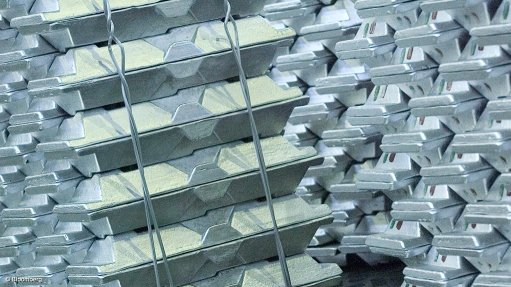Water taken from Sterkfontein still not replaced – Muller

Video Flashback: Wits School of Governance visiting adjunct professor Mike Muller talks to Mining Weekly Online Martin Creamer on the urgency of ensuring long-term water supply. Photographs: Duane Daws. Video and Editing: Nicholas Boyd.
JOHANNESBURG (miningweekly.com) – Water extracted from the Sterkfontein dam had still not been replaced, six months after officials promised that it would be, Wits School of Governance visiting adjunct professor Mike Muller has pointed out.
Speaking at this week’s South African Institution of Civil Engineering Civilution conference, the former Department of Water Affairs director-general emphasised the need for concern about the water resources that underpin water supply.
Muller told the conference that in December, for some reason, Water Affairs Minister Nomvula Mokonyane and her officials decided to release 10% of the water in Sterkfontein, the strategic water reserve of the province of Gauteng.
“That is enough to keep Rand Water working for two months. They promised to replace it rapidly,” he explained.
Six months later, the dam was still 10% lower than it should be.
“We need the Minister to explain why her department is reducing Gauteng’s water security and what she is going to do about it.”
The National Development Commission then-commissioner, who chaired the World Economic Forum’s Global Agenda Council on Water Security from 2012 to 2014, warned that if this year’s drought continued into the next season, Gauteng could face the risk of severe restrictions.
The third largest dam in South Africa, Sterkfontein holds more water than Vaal dam.
It is not filled by a river but by working with State electricity utility Eskom to pump water from the Thukela river in KwaZulu-Natal.
Muller outlined how Gauteng faced similar challenges with the construction of the second phase of the Lesotho Highlands Water Scheme.
“That project is already six years late,” he said, adding that it was supposed to be completed by 2018.
However, the design of the dam and tunnel had not even begun.
Although the Cabinet had authorised the procurement of consultants months ago, tenders had still not been issued, he decried.
While Lesotho was ready to proceed, South Africa was holding up the process.
“What is the problem? Is somebody trying to do a deal with this vital project? We cannot afford to put the security of Gauteng’s economy at risk like this,” said Muller.
However, he complimented the department and the professionals concerned on the progress that had been made on the management of acid mine drainage (AMD).
Careful study and preparation had produced a phased response towards reducing the volume of water going into the ground, which determined the volume of water that would emerge to be treated.
But the next phase of the project had still to proceed and there appeared to be infighting about who would take the lead.
DESALINATION
Similar structured approaches would be needed to use desalination to address the challenges of expanding water supply in South Africa’s coastal cities, where desalination was an obvious alternative but needed to be carefully implemented.
“We must not wait until there is a crisis, as the Australians did, before we start,” Muller cautioned.
Neither should the country opt for desalination ahead of cheaper local sources “just because we can do a deal, as the Nelson Mandela Bay municipality tried to do”.
Desalination needed to be introduced as part of a system, as an outcome of careful systems analysis that took into account costs and options.
It would be interesting to see whether Ethekwini or Cape Town took the first step.
In a video interview with Creamer Media’s Mining Weekly Online in December, Muller pointed out that even if the contract for the second phase of the Lesotho Highlands Water Scheme were signed now, water from it would only be available in 2024, which could result in a water shortage in Gauteng and the surrounding provinces reliant on the Vaal river system. (Also watch attached Creamer Media video).
“We know that around 2018 to 2020 the capacity of the Vaal system to provide water, if there is a serious drought like we’re having now, will be insufficient, and we need to take some measures to deal with that, but some of those measures are going to take time,” Muller said.
He also urged action on AMD and described as “embarrassing” the South African government being slower than the Lesotho government to decide on the Lesotho Highlands Water Scheme’s second phase.
“I get worried. This is how we got into the energy crisis. We had everything in place but somehow the decision just didn’t get taken,” Muller told Mining Weekly Online at the time.
He conceded that the Lesotho project’s process was “complicated, delicate and nuanced” involving two governments, a treaty, an estimated R10-billion capital cost and Lesotho running the procurement process and South Africa providing the funding at a time of significant financial stringency.
South Africa’s Trans-Caledon Tunnel Authority (TCTA) and the Lesotho Highlands Development Authority were required to work together to decide how to proceed and then to implement that decision.
The two governments had to study the implications and consumers in South Africa would need to start paying immediately once the contract was signed to avoid a sharp rise in water tariffs, as has taken place with electricity.
Tariffs needed to be increased slowly over time so that consumers would have grown accustomed to paying additional amounts, as had happened with Phase 1B.
That approach could be repeated with Phase 2, but it meant National Treasury, the Department of International Relations and Cooperation, the Department of Water Affairs and Sanitation, TCTA and Rand Water getting their act together.
The Water Affairs Minister needed to present Lesotho Highlands Water Scheme proposals and AMD project decisions to the Cabinet, together with an outline to the Finance Minister of the required capital expenditure.
As Department of Water Affairs director-general from 1997 to 2005, Muller was responsible for the development and implementation of policy and legislative reform and initiation of a range of national water programmes and projects that gave ten-million people access to safe water.
He also co-chaired water-sharing negotiations with Mozambique and Swaziland and led the South African side in earlier Lesotho project talks.
Before that, he was responsible for infrastructure and policy programmes at the Development Bank of Southern Africa and managed water and sanitation programmes for the Mozambique government from 1979 to 1988.
“I venture to say, because we keep changing Ministers, I don’t think the Ministers actually even understand what needs to be done."
He urged that Ministers be challenged to explain why they were taking so long. “Ask them to explain why the Lesotho government has asked South African parliamentarians to come and discuss the delays, which I believe has just happened,” Muller said, adding that he found it interesting that Lesotho should have to “very politely” call the South African government to account for the delays.
In cost terms, Lesotho water, which was gravitationally fed into the Vaal, remained the cheapest currently available way to increase supply into the Vaal system. (Also watch attached Creamer Media video).
AMD treatment would be significantly more expensive and would require the intensive use of scarce electricity. But the bigger danger was that neither the one nor the other would be ready in time. Should a drought cut supply, water authorities would have no option but to cut consumption, in the same way as State utility Eskom had done with load-shedding. In Port Elizabeth, where the local authority failed to build a treatment works and pipeline even though there was adequate water available to bring into the city, factories had been asked to close down.
“We don’t want to have to do that. If we are to avoid that, we have to take the right decisions at the right time and then implement them,” Muller added.
South Africa has a water plan that extends to 2030 and which is modified to meet demand. Apart from the Lesotho water and the water that flows naturally into the Vaal river, water from the Thukela river in KwaZulu-Natal is pumped, also using a lot of electricity, over the Drakensberg into the Sterkfontein dam and then the Vaal.
Water from the Komati river, used by Eskom power stations in Mpumalanga, is also brought into the Vaal system. As part of the overall plan to 2030, various locations have their own particular water sources and their own particular challenges.
The Umkomaas river has an abundance of water to serve the area of Durban, but to build a dam and pipeline to transfer it to the north of Durban, where the demand is building up, will be costly. It could be argued that building a desalination plant north of Durban, to obtain water from the sea, which is under discussion and also energy intensive, would save considerable capital, but then during periods of drought, the cost of desalinated water would rocket.
Again, the economics needed to be worked out and decisions taken. The Cape Town area, which would need more water in the next ten years, could also decide to build a desalination plant or to recycle wastewater that currently goes out to sea or to go for groundwater sources that have been discovered.
Muller’s preference would be for AMD – which accounts for 15% of water pollution with urban wastewater, agriculture and industry making up the other 85% – to be allowed to settle deep underground rather than being pumped back to surface and treated at high expense and energy intensity.
While it was convenient to treat AMD because of its emergence from a limited number of locations, it was much harder to control municipalities and farmers, and it might be wiser to retain funds for the solving of the far larger 85% problem.
While the immediate water focus was on municipalities losing much to leaks and consumers not paying for water, South Africa needed to be strategic and also worry about where the municipalities were going to get their water resources in the future.
“If we don’t keep our eye on those long-term projects, we can be running around and putting our fingers in the dyke and fixing leaking pipes, but if in ten years’ time there is no water to go into those pipes, there won’t be any leaks, but there also won’t be any water for you and me,” Muller commented to Mining Weekly Online. (Also watch attached Creamer Media video).
Comments
Press Office
Announcements
What's On
Subscribe to improve your user experience...
Option 1 (equivalent of R125 a month):
Receive a weekly copy of Creamer Media's Engineering News & Mining Weekly magazine
(print copy for those in South Africa and e-magazine for those outside of South Africa)
Receive daily email newsletters
Access to full search results
Access archive of magazine back copies
Access to Projects in Progress
Access to ONE Research Report of your choice in PDF format
Option 2 (equivalent of R375 a month):
All benefits from Option 1
PLUS
Access to Creamer Media's Research Channel Africa for ALL Research Reports, in PDF format, on various industrial and mining sectors
including Electricity; Water; Energy Transition; Hydrogen; Roads, Rail and Ports; Coal; Gold; Platinum; Battery Metals; etc.
Already a subscriber?
Forgotten your password?
Receive weekly copy of Creamer Media's Engineering News & Mining Weekly magazine (print copy for those in South Africa and e-magazine for those outside of South Africa)
➕
Recieve daily email newsletters
➕
Access to full search results
➕
Access archive of magazine back copies
➕
Access to Projects in Progress
➕
Access to ONE Research Report of your choice in PDF format
RESEARCH CHANNEL AFRICA
R4500 (equivalent of R375 a month)
SUBSCRIBEAll benefits from Option 1
➕
Access to Creamer Media's Research Channel Africa for ALL Research Reports on various industrial and mining sectors, in PDF format, including on:
Electricity
➕
Water
➕
Energy Transition
➕
Hydrogen
➕
Roads, Rail and Ports
➕
Coal
➕
Gold
➕
Platinum
➕
Battery Metals
➕
etc.
Receive all benefits from Option 1 or Option 2 delivered to numerous people at your company
➕
Multiple User names and Passwords for simultaneous log-ins
➕
Intranet integration access to all in your organisation



















